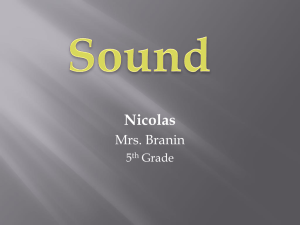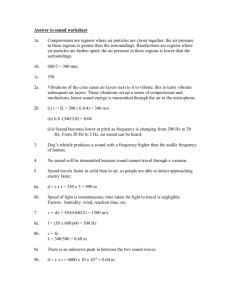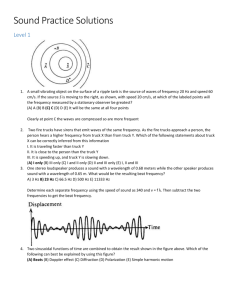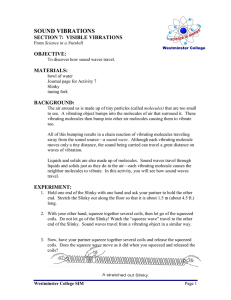Name: Class : Physics Test Sound What is the source of sound? (1
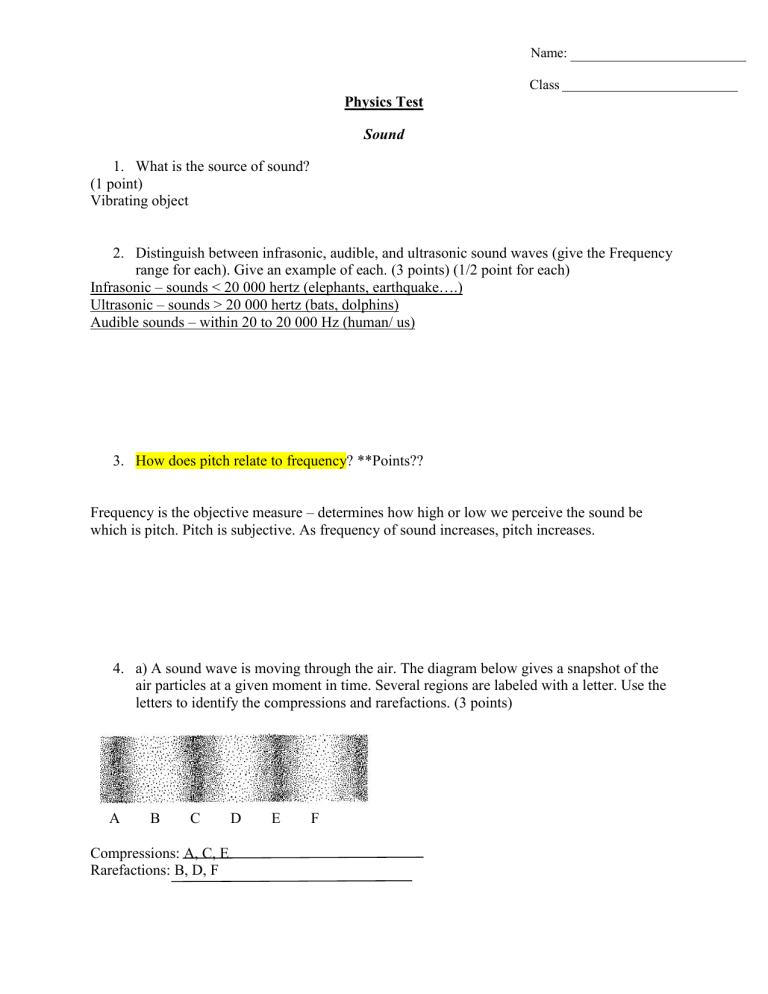
Name:
Class
Physics Test
Sound
1.
What is the source of sound?
(1 point)
Vibrating object
2.
Distinguish between infrasonic, audible, and ultrasonic sound waves (give the Frequency range for each). Give an example of each. (3 points) (1/2 point for each)
Infrasonic – sounds < 20 000 hertz (elephants, earthquake….)
Ultrasonic – sounds > 20 000 hertz (bats, dolphins)
Audible sounds – within 20 to 20 000 Hz (human/ us)
3.
How does pitch relate to frequency? **Points??
Frequency is the objective measure – determines how high or low we perceive the sound be which is pitch. Pitch is subjective. As frequency of sound increases, pitch increases.
4.
a) A sound wave is moving through the air. The diagram below gives a snapshot of the air particles at a given moment in time. Several regions are labeled with a letter. Use the letters to identify the compressions and rarefactions. (3 points)
A B C D E F
Compressions: A, C, E
Rarefactions: B, D, F
: b). Distinguish between compressions and rarefactions
Compressions are regions of high pressure, while rarefactions are areas of low pressure
5.
Here is a picture of a vibrating tuning fork. How is the position of the air molecules related to the motion of the prongs over time?
3 points (1/2 point for saying prongs go forward, ½ point saying that air molecules pushed surround air molecules to their nearest neighbor and ½ point referring to compression)
(1/2 point saying vibrating prong moves in reverse direction, ½ point saying it lowers air to the right causing air molecules to move left, ½ point rarefaction).
As the vibrating prong moves in the forward direction, it begins to push upon surrounding air molecules, moving them to the right towards their nearest neighbor. These air molecules are
“compressed” into a small region of space. This region is an area of high pressure and is called a compression.
As the vibrating prong moves in the reverse direction (left) it lowers the pressure of the air immediately to its right causing air molecules to move back left. This creates a region of low pressure called a rarefaction
6.
Explain how compressions and rarefactions are produced (1 point)
Vibrating source/ object
:
7.
Sally observes that light can travel through a vacuum because she can see the sun or moon. She concludes that if something blew up on the moon she would be able to hear it.
Is Sally Correct? Explain why or why not. (2 points)
No- Sally is incorrect (1 point). Sound requires a medium to travel through (1 point) – space is a vacuum (1/2) and thus no medium for sound waves to travel through (1/2)
8.
Sound pulses emitted by a dolphin travel through 20 o
C ocean water at a rate of 1450m/s.
In 20 o
C air, these pulses would travel 342.9 m/s. How can you account for the differences in speed? (2 points)
Sound waves travel faster through water than through air (1 point) because the molecules of water are closer together and as a result, can spread vibrations more quickly. (1 Point)
9.
Please circle the correct response (1 point).
An engineer in a moving train blows the train’s horn. The train is moving away from a person standing on the ground. Compared to the frequency of the sound that the engineer hears, the person standing on the ground hears a sound with D
A) The same wavelength
B) More variation in tone
C) Greater amplitude
D) A lower frequency
10.
Consider the diagram below
:
A B a) Which person hears the highest frequency? (1point) (Person B)
Why? (1 point)
Because the sound waves reach person B more frequently b) Towards which person does the sound wave travel the fastest? (1 point) Not A not B
Why? (1 point) (Neither person) speed of the sound does not change.
11.
The Doppler Effect is a phenomenon that is observed only of sound waves. (1 point)
True or False.
False
12.
a) Loudness is subjective and sound intensity is objective. True or False. (1 point)
True b) Why? (1 point)
Loudness is subjective based on physiological – on hearing. Sound intensity is objective and can be measured by instruments
13.
Two tuning forks of the same frequency are spaced about a meter apart. What will happen when one of the forks is struck. Explain. (2 points)
When one of the forks is struck, it sets the other fork into vibration because the vibration forced on the second fork matches the fork’s natural frequency and keep it vibrating (called resonance).
14.
Please circle the correct response.
:
The speed of sound waves depends upon the (D)
A) Frequency of the wave
B) Wavelength of the wave
C) Amplitude of the wave
D) Properties of the medium through which it moves
15.
Describe natural frequency.
Natural frequency is when any object composed of an elastic material is disturbed, it vibrates at its own special set of frequencies.
16.
Opera singers have been known to set crystal goblets in vibration with their powerful voices. In fact, an amplified human voice can shatter the glass, but only at certain fundamental frequencies. Why will only certain frequencies break the glass? (2 points)
Only frequencies that match one of the natural frequencies of the glass can establish a resonance condition. Only then can the vvibrations become large enough to shatter the goblet.
17.
Sony asks you to create a stringed musical instrument. How would you create this instrument to make sure that the sound produced is audible? Be sure to explain why you think you need each component (6 points??)
Needs strings – all sounds originate in the vibrations of material objects – these are important so that when plucked/strummed sound wave is produced by the vibrating object
Strings need to be stretched and attached to a body/ cavity/sound box – would be good if this body had a hole in it – the vibrating string then can force the sound box into vibrating at that same natural frequency. Sound box then can force air particles inside the box into vibrational motion at same natural frequency as the string. Sound board needs to be greater than the surface area of the string so that more surrounding air particles will be forced into vibration and increased loudness
:
18.
Please circle the correct answer (1 point).
In the diagram below the listener is equally distant from two sound speakers that simultaneously trigger identical sound waves of constant frequency. What will the listener hear?
A) The listener hears a louder sound because the waves arrive in phase and add
B) The listener hears no sound
C) The listener hears a fainter sound because the waves arrive out of phase.
A
19.
What is the result that occurs when the path lengths from two identical sources differ by half a wavelength? (2 points? Or 1 point?)
Destructive Interference – the crests of one coincide with the troughs of the other.
Yes
20.
a) Is interference of sound related to beats? (1 point)
b) Explain why or why not.
Beats are a result of periodic interference
:

